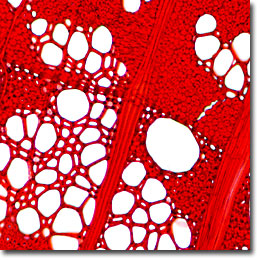The American Elm
The American (or White) elm (Ulmus americana) is a hardwood tree comprised of three primary species whose habitat ranges from central Canada to Texas and east to the Atlantic Ocean. Principle features of elm timber are the pore rings having a single row of vessels that are very uniform in size and often visible to the unaided eye. The sapwood is grayish white to light brown, and the thick heartwood ranges from light to dark brown, often with a reddish tinge.

Cross Section

Radial Section

Tangential Section
This native tree is another important species that has fallen victim to the fungal blight called Dutch Elm Disease, which was first discovered in 1930 and has since killed hundreds of thousands of trees. Efforts are being made to develop disease-resistant strains of the Elm tree, but like all tree research, this will probably take many years. Elm wood, with its ability to withstand rough handling and superior bending qualities, is useful for making boxes, crates, and furniture (especially with bent parts such as rockers).
As revealed in the digital images of stained (iron-alum hematoxylin and safranin) thin sections presented above, the minute structure of the wood shows a porous texture with simple perforation plates. Vascular tracheids, having spiral thickening, are present in the early-wood porous zones and the wavy bands comprising late-wood vessels. The rays are unstoried and generally 3 to 6 seriate and homocellular. Ray-vessel pitting is simple to bordered.